Physical Address
304 North Cardinal St.
Dorchester Center, MA 02124
![]() Access the accompanying videos for this chapter online. Available on ExpertConsult.com .
Access the accompanying videos for this chapter online. Available on ExpertConsult.com .
Choledochal cyst is a traditional term representing a congenital dilatation of the biliary tract. Choledochal cysts are classified into five types:
Type I
Ia. Cystic dilatation of the choledochus
Ib. Fusiform dilatation of the choledochus
Type II: Diverticulum of choledochus
Type III: Choledochocele
Type IV
IVa: Multiple cysts of the extra- and intrahepatic ducts
IVb: Multiple cysts of the extrahepatic duct
Type V: Intrahepatic duct cysts
Forme fruste is a special form of choledochal cyst with pancreaticobiliary malunion but little or no dilatation of the extrahepatic duct.
A laparoscopic operation can be utilized for type I, type II, type IV, and forme fruste choledochal cysts. Choledochal cysts detected prenatally can be operated on between 3 and 6 months of age if there is no manifestation of biliary obstruction. However, the operation should be performed earlier if biliary obstruction is present. Choledochal cysts detected postnatally can be operated on whenever the patient’s condition allows.
Biochemical tests are required to evaluate the liver function. Abdominal ultrasound is the initial imaging investigation to assess the size, the location of the cyst, and associated dilatation of intrahepatic tracts. Magnetic resonance cholangiopancreatography (MRCP) can be performed to obtain accurate anatomy of the whole biliary system, especially the common pancreaticobiliary channel. Intraoperative cholangiography is recommended if MRCP cannot provide a detailed anatomic reconstruction of the biliary tract and common pancreaticobiliary channel.
General anesthesia is used. A nasogastric tube, rectal tube, and urinary catheter are all inserted to decompress the stomach, colon, and bladder. The patient is placed in a 30-degree head-up supine position. The surgeon stands or sits on a chair at the lower end of the operating table between the patient’s legs. For a newborn or infant, the patient is positioned transversely at the end of the table. The surgeon stands or sits on a chair at the feet of the patient.
A 10-mm cannula is inserted through the umbilicus for the telescope. Three additional 5- or 3-mm ports are placed for instruments: one at the right flank, one at the left flank, and the final one in the left hypochondrium ( Fig. 23-1 ). A carbon dioxide pneumoperitoneum is maintained at a pressure of 8 to 12 mm Hg depending on the child’s age.
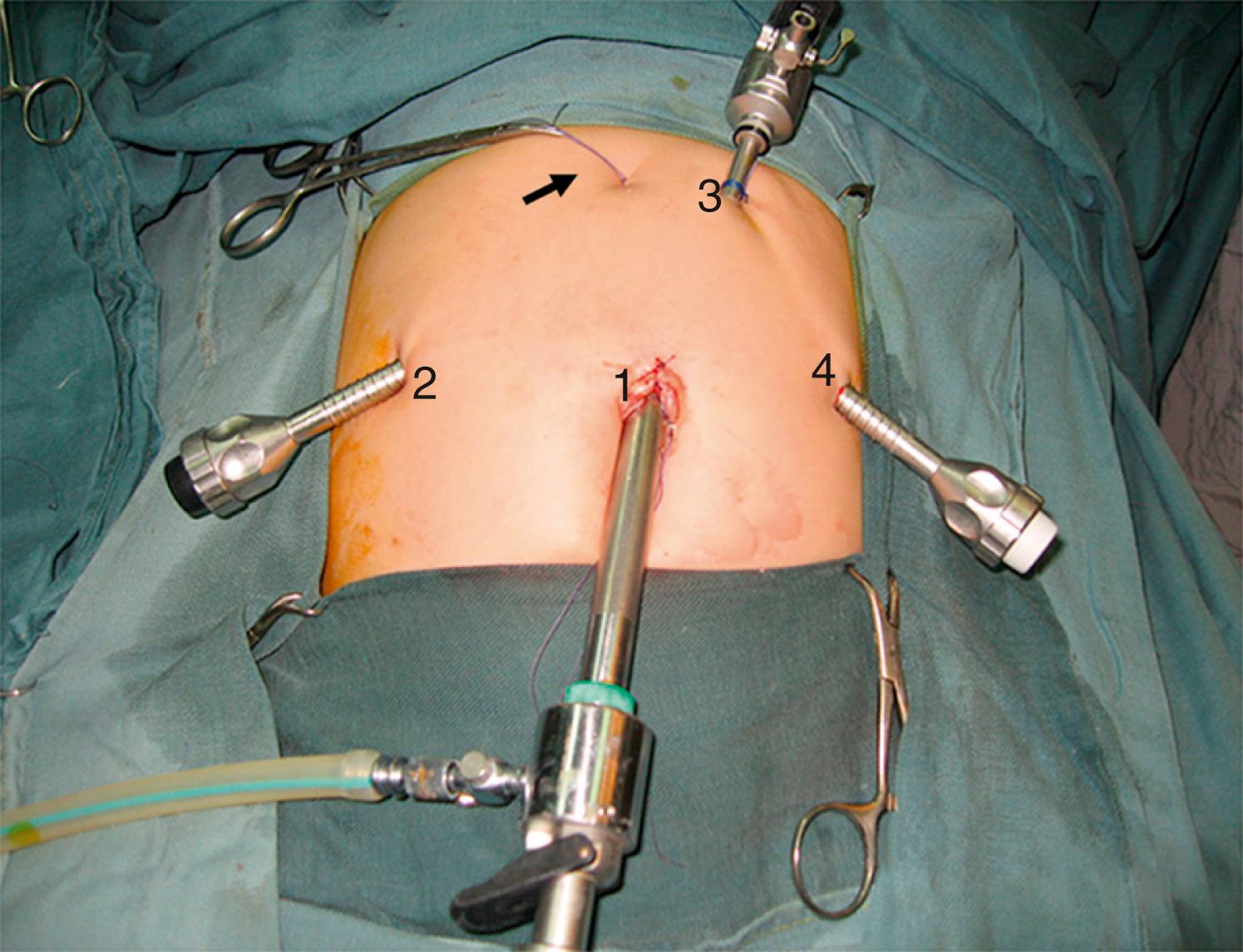
The liver is secured to the abdominal wall by a stay suture placed around the round ligament ( Fig. 23-2A ). The cystic artery is identified, clipped, and divided. The cystic duct is also isolated, clipped, and divided. A second traction suture is then placed at the junction of the distal cystic duct and the fundus of the gallbladder to retract the liver and splay out the liver hilum ( Fig. 23-2B ).
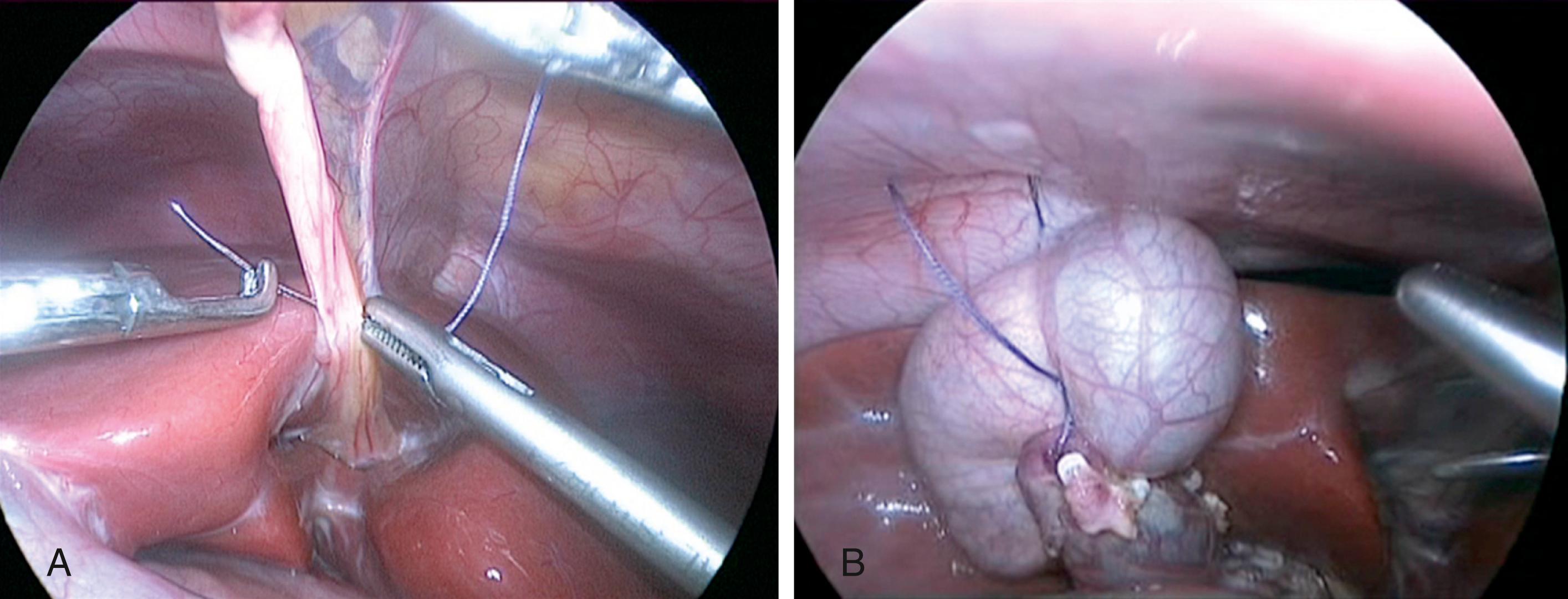
The duodenum is retracted downward using a dissector through the fourth port site. The midportion of the cyst is dissected circumferentially using a 3-mm Kelly forceps for both dissecting and coagulation. Separation of the cyst from the hepatic artery and portal vein is carried out meticulously ( Fig. 23-3 ). A dissector is passed through the space between the posterior wall of the cyst and portal vein proceeding from the left to the right ( Fig. 23-4A ).
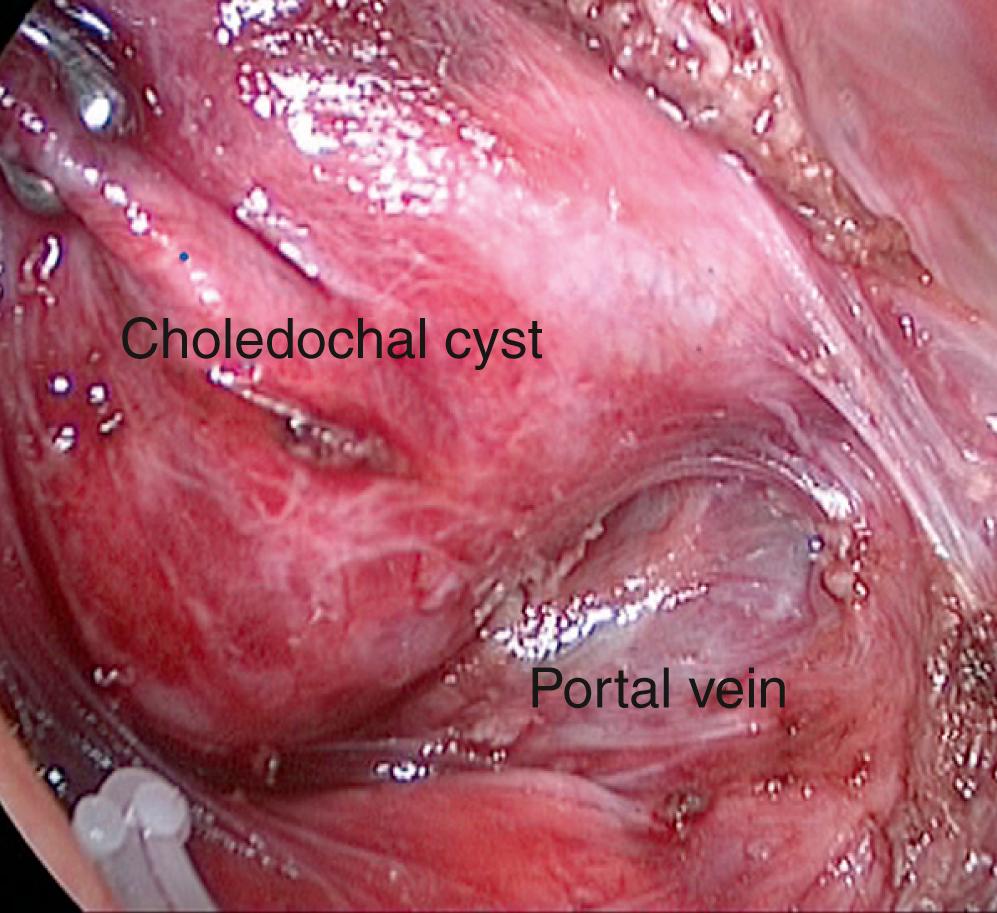
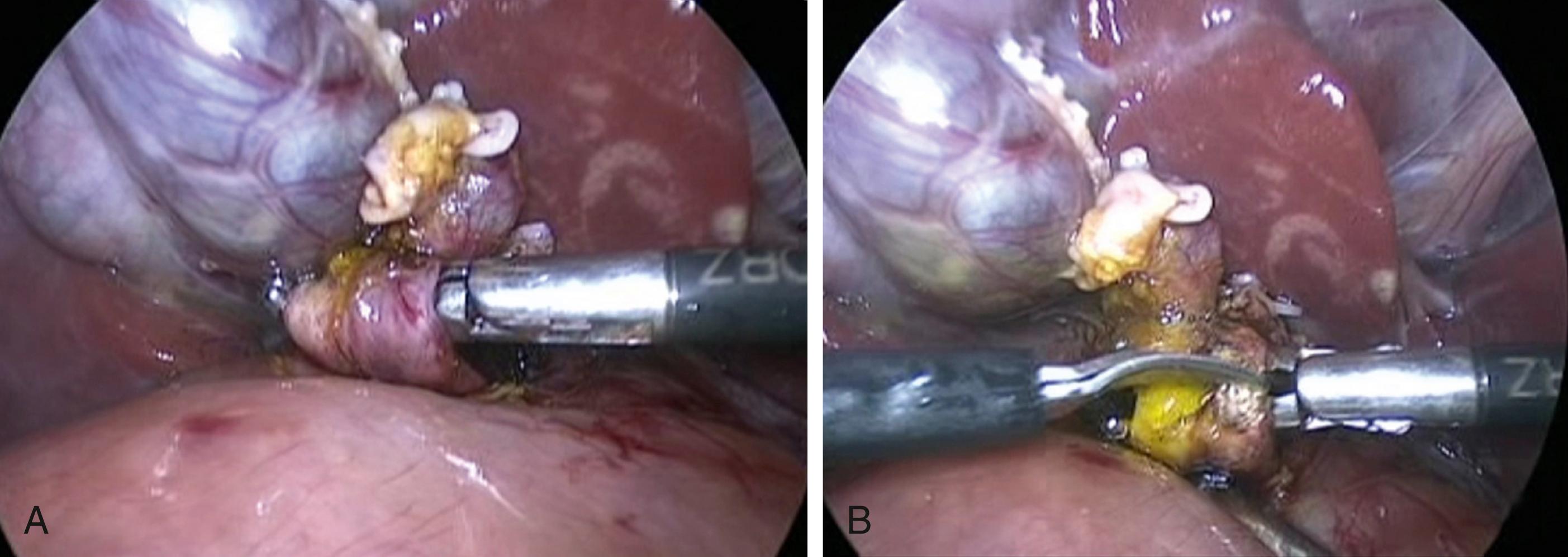
The cyst is then divided at this site ( Fig. 23-4B ). The lower part of the cyst is detached from the pancreatic tissue down to the common biliary-pancreatic duct. The distal part of the cyst is opened longitudinally to identify the orifice of the common channel. A catheter is inserted through the common duct’s orifice and irrigation with normal saline via this catheter is performed ( Fig. 23-5A ). The inspection and irrigation can be performed through a pediatric cystoscope if the common channel is wide enough. The distal choledochal cyst is then clipped and divided at the level of the orifice of the common channel ( Fig. 23-5B ).
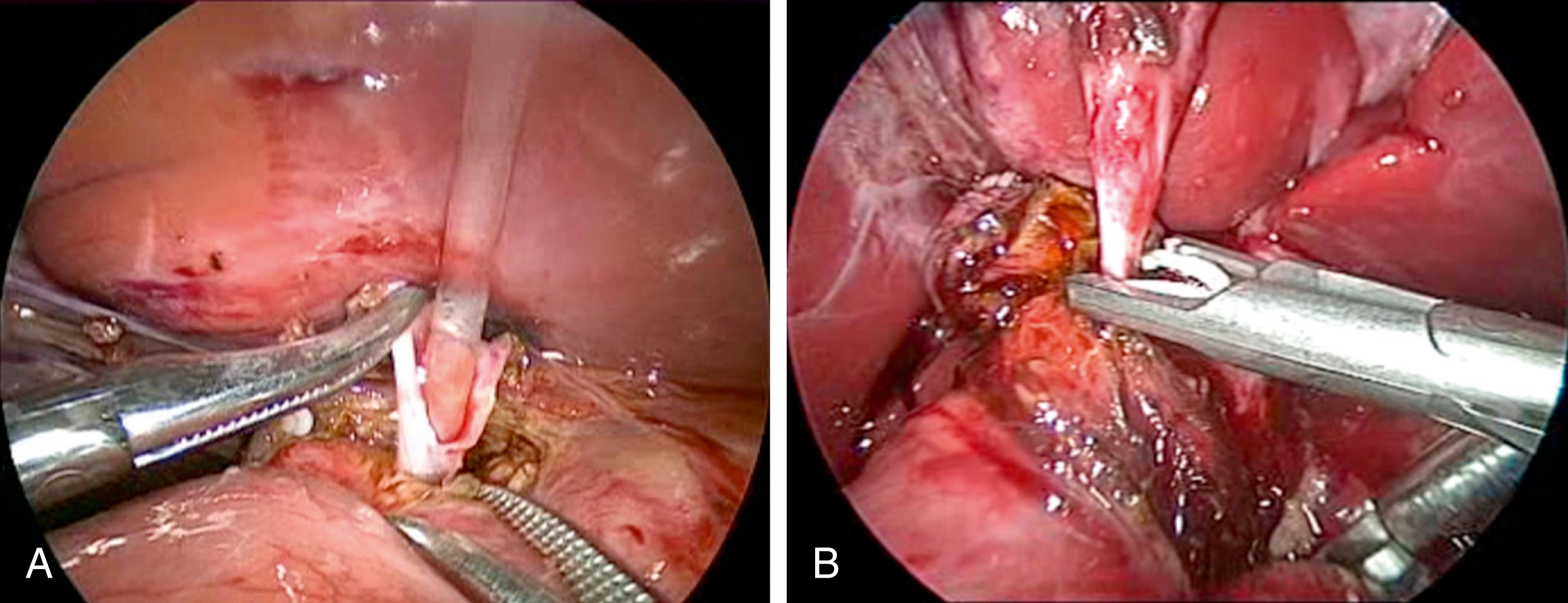
The upper part of the cyst is now dissected up to the common hepatic duct and divided. The choledochal cyst is initially divided at the level of the cystic ducts. The definitive division is performed after inspecting the orifice of the common bile duct. The common hepatic duct is irrigated with normal saline to wash out biliary debris and calculi. Irrigation with normal saline through a small catheter inserted into the right and then into the left hepatic duct is performed to wash out the protein plugs or calculi until the effluent from those ducts is clear.
With a large cyst, reduction of the cyst volume is performed by aspiration of bile through a catheter inserted into the gallbladder or through a small puncture on the anterior wall of the cyst. The dissection is started at the middle portion, proceeding distally. The distal portion of the choledochal cyst is separated from the portal vein. The distal common bile duct is divided above the biliary-pancreatic duct. Irrigation with normal saline in the remnant is performed to wash out debris and calculi. The distal common bile duct is then clipped and transected at the level of the common channel orifice.
When the cyst is intensely inflamed and extensive pericystic adhesion is present, the cyst is opened transversely on its anterior wall, and then the separation of the cystic wall from the portal vein is carried out carefully while viewing the cyst internally and externally. After dividing the midportion of the cyst, the upper and lower parts of the cyst are removed as described previously.
Become a Clinical Tree membership for Full access and enjoy Unlimited articles
If you are a member. Log in here